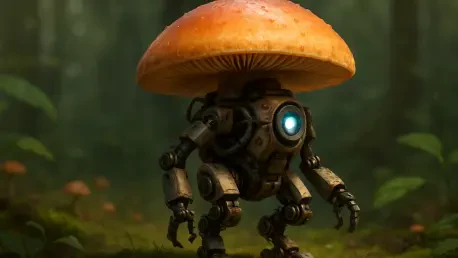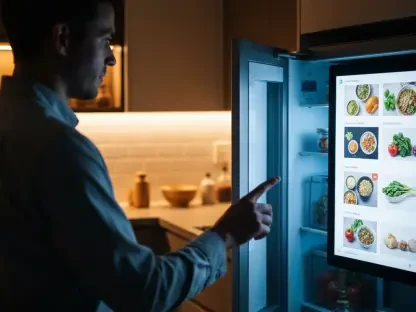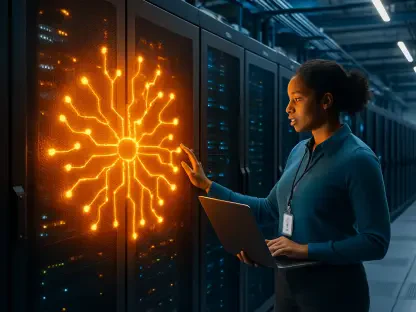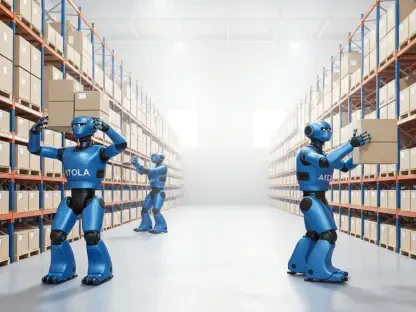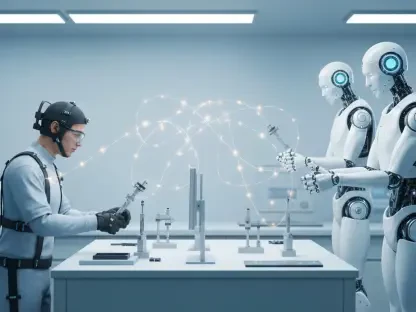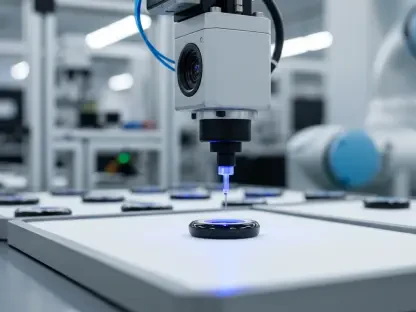In an era where the boundaries between technology and nature are increasingly blurred, a remarkable breakthrough from Cornell University has sparked intrigue and excitement in the world of robotics. Researchers have pioneered an extraordinary fusion by integrating the living tissue of King Oyster mushroom mycelium with mechanical systems, creating biohybrid robots that can sense and respond to their surroundings in ways that traditional machines simply cannot match. This innovative approach challenges the conventional foundations of robotic design, moving away from rigid, pre-programmed systems toward a synergy of biological and synthetic elements. The implications of this development are profound, suggesting a future where robots don’t just mimic life but incorporate living systems as core components of their functionality. This intersection of biology and engineering opens up uncharted territory, promising solutions to real-world problems through a harmonious blend of nature’s resilience and technology’s precision.
Unveiling the Mycelium-Robot Synergy
The groundbreaking work at Cornell’s Engineering department has introduced a novel concept in robotics by utilizing mycelium—the intricate, root-like network of fungal threads—as a living control mechanism for robots. Unlike traditional robots that depend on silicon-based processors and fixed programming for operation, these biohybrid creations leverage the natural electrical impulses generated by mycelium to guide their movements and react to environmental stimuli such as light or physical contact. This integration represents a significant departure from standard robotics, embedding a form of biological autonomy that allows for more organic and adaptive interactions with the world. By tapping into the inherent capabilities of a living organism, this approach not only redefines how robots can function but also highlights the potential for nature-inspired solutions to enhance technological innovation in unprecedented ways, setting a new benchmark for what machines can achieve.
This development also underscores a philosophical shift in the field of robotics, moving beyond mere mechanical control to a deeper connection with living systems. The mycelium’s ability to produce electrical signals in response to external changes offers a unique pathway for robots to engage with their environment more intuitively than ever before. While traditional sensors are often external additions to a robotic framework, the use of mycelium integrates sensing and control directly into the system, creating a seamless loop between biological input and mechanical output. The Cornell team’s success in translating these faint biological signals into actionable digital commands marks a pivotal moment, demonstrating that living tissues can serve as more than just passive components—they can actively direct robotic behavior. This synergy between fungal networks and engineered hardware paves the way for machines that are not only functional but also inherently responsive to the complexities of their surroundings.
The Unique Advantages of Mycelium
What sets mycelium apart as a game-changer in biohybrid robotics is its exceptional adaptability and durability, qualities that outshine other biological materials often explored in similar systems. Unlike animal cells, which require meticulously controlled environments and constant maintenance to remain viable, mycelium thrives even in harsh, unpredictable conditions with minimal resources. It can detect a wide range of environmental factors, including temperature shifts, chemical presence, and humidity levels, making it a robust choice for robots intended for outdoor or challenging terrains where elements like dust, weather extremes, and vibrations pose significant threats. This resilience positions mycelium as a practical and sustainable option for integrating living systems into technology, offering a stark contrast to the fragility of other biohybrid approaches and highlighting its potential to revolutionize how robots operate in real-world scenarios beyond the confines of a lab.
Further emphasizing mycelium’s appeal is its low-maintenance nature, which addresses one of the biggest hurdles in biohybrid robotics—sustainability over extended periods. While other biological components might degrade or fail without stringent care, mycelium’s ability to grow and function on sparse nutrients reduces the logistical burden of maintaining such systems. Its sensitivity to diverse stimuli also means that robots equipped with this fungal network can perform complex tasks without the need for an array of synthetic sensors, streamlining design and cutting costs. The natural versatility of mycelium enables these biohybrid robots to tackle environments that would typically challenge conventional machinery, from rugged landscapes to industrial zones. As a result, this unique biological material not only enhances the functional scope of robotics but also pushes the industry toward more environmentally friendly and resource-efficient innovations that align with broader sustainability goals.
Tackling the Technical Barriers
Integrating a living entity like mycelium into a robotic framework presented significant technical challenges, particularly in managing the delicate balance between biological signals and mechanical operations. One of the primary obstacles was the interference caused by electrical noise from motors, wiring, and surrounding conditions, which risked overpowering the subtle electrical impulses emitted by the mycelium. To overcome this, the Cornell research team engineered a specialized shielded interface that minimizes vibrations and electromagnetic disturbances, ensuring that the fungal signals could be captured clearly even as the robot moved. This advancement is notable, as it addresses a common issue in biohybrid systems where motion often disrupts the integrity of living sensors, paving the way for more reliable and consistent performance in dynamic settings where precision is critical.
Beyond hardware solutions, the team also focused on software innovations to refine the control process, ensuring that the mycelium’s signals could be effectively translated into robotic actions. By developing algorithms that prioritize the rhythm of electrical spikes over intricate signal patterns, they created a robust system capable of maintaining functionality amidst potential disruptions. This focus on rhythmic patterns rather than exhaustive data decoding prevents the system from being overwhelmed by noise, allowing for smoother operation. The combination of shielded interfaces and adaptive software demonstrates a comprehensive approach to overcoming the inherent difficulties of merging biological and synthetic components. Such solutions not only validate the feasibility of mycelium-driven robotics but also set a precedent for future research into biohybrid technologies, showing that with the right tools, the challenges of integrating living systems into machines can be systematically addressed.
Harnessing Nature’s Rhythmic Blueprint
Inspired by the natural mechanisms of biological central pattern generators—neural circuits in living organisms that orchestrate rhythmic movements—the Cornell researchers utilized mycelial electrical pulses to establish the timing for robotic motion. This innovative method allows biohybrid robots, whether configured as spider-like walkers or compact wheeled rovers, to adapt their gait in real time as environmental conditions influence the mycelium’s rhythm. By mapping these biological beats to motor functions, the system achieves coordinated movement without the need to micromanage every mechanical joint, simplifying control processes. This nature-inspired strategy not only enhances the fluidity of robotic actions but also showcases how biological principles can inform and improve technological designs, offering a fresh perspective on autonomous systems that operate with a level of organic responsiveness.
The emphasis on rhythm over detailed signal interpretation also serves as a practical solution to the challenges of working with noisy biological data in a mechanical context. By concentrating on the consistent timing of mycelial impulses, the system avoids the pitfalls of overfitting to erratic inputs, ensuring stability even in fluctuating environments. This approach mirrors how living creatures adapt their movements to changing circumstances, providing a blueprint for robots that can navigate complex terrains or react to sudden stimuli with grace and efficiency. The success of this rhythmic integration in experimental prototypes underlines its potential to redefine robotic locomotion, moving away from rigid, predetermined patterns toward a more flexible and adaptive framework. As a result, this method bridges the gap between biological intuition and engineered precision, setting a foundation for future advancements in how robots interact with the world around them.
Envisioning Practical Impacts
The practical implications of mycelium-powered biohybrid robots are both diverse and transformative, with early experiments already demonstrating their capability to respond to environmental cues like ultraviolet light by adjusting movement patterns based on mycelial activity. This ability to react in real time hints at a wealth of applications, particularly in agriculture, where such robots could revolutionize resource management. By sensing chemical compositions in soil, including nutrient levels or harmful pollutants, these machines could enable precise delivery of fertilizers or treatments, reducing waste and mitigating environmental damage such as runoff that contributes to issues like algal blooms. This targeted approach promises to enhance efficiency in farming practices, aligning with global efforts to promote sustainable land use while addressing pressing ecological concerns through cutting-edge technology.
Another compelling area of impact lies in the adaptability of these robots to perform tasks that require nuanced environmental interaction beyond simple mechanical functions. The integration of mycelium allows for a level of sensitivity that could transform how data is gathered in fields like precision agriculture, where understanding subtle variations in soil conditions can make a significant difference in crop yield and resource allocation. Unlike traditional robotic systems that rely on bulky or limited sensor arrays, mycelium-equipped robots offer a built-in, organic detection system that responds naturally to a range of stimuli. This capability could lead to innovations in how agricultural challenges are addressed, from optimizing water usage to detecting early signs of soil degradation. As research progresses, the potential to scale these applications could reshape industries that depend on environmental interaction, making biohybrid robots a cornerstone of future technological solutions.
Pioneering Environmental Solutions
Biohybrid robots powered by mycelium also hold immense promise for environmental monitoring, particularly in harsh or variable conditions where conventional sensors often falter. Their capacity to detect toxins, pathogens, or other critical indicators in wet, dirty, or unstable environments offers a durable, low-cost alternative for addressing real-world challenges. Whether deployed in remote wetlands to monitor water quality or in industrial zones to identify chemical leaks, these robots could provide actionable insights without the high maintenance demands of traditional equipment. The inherent resilience of mycelium ensures that such systems can operate effectively over extended periods, even in settings that would typically degrade synthetic components, positioning them as vital tools for safeguarding ecosystems and public health in an increasingly complex world.
Expanding on this potential, the use of mycelium in robotics could redefine how environmental data is collected and acted upon, especially in scenarios requiring continuous or long-term surveillance. The natural sensitivity of fungal networks to chemical and biological changes means that these robots could serve as early warning systems for pollution or contamination, enabling faster response times to mitigate damage. Unlike static monitoring devices, their mobility allows for dynamic coverage of large or difficult-to-access areas, enhancing the scope and accuracy of environmental assessments. This adaptability could prove invaluable in efforts to combat climate change impacts or industrial hazards, offering a sustainable method to track and address issues as they arise. As development continues, the integration of such biohybrid systems into environmental strategies could mark a significant leap forward in how technology supports planetary stewardship, blending nature’s insights with engineered solutions.
Reflecting on a Biological Revolution
Looking back, the pioneering efforts at Cornell University to merge mushroom mycelium with robotic systems stand as a defining moment in the evolution of biohybrid technology. The successful demonstration of robots that could sense ultraviolet light and adapt their movements through natural electrical signals showcased a level of integration between biology and machinery that was once thought unattainable. The resilience and versatility of mycelium proved to be a game-changer, offering a stark contrast to the limitations of other biological materials and traditional sensors. As challenges like signal interference were met with innovative solutions such as shielded interfaces and rhythm-based software, the path was cleared for practical applications in agriculture and environmental monitoring. Moving forward, the focus must shift to refining the stability and scalability of these systems, exploring broader sensing capabilities like chemical detection, and validating performance across diverse real-world conditions. This foundation sets the stage for a future where the union of living systems and technology could address some of the most pressing global issues with unprecedented ingenuity.
